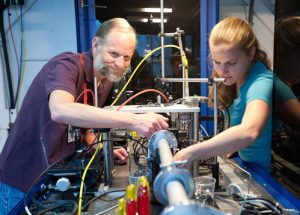
Earliest new EV battery chemistry available likely to be 2035 or 2040
Q. Why build North American pipelines, expand Texas shale production and the Alberta oil sands, if electric vehicles will replace internal combustion engine cars in a decade or two? A. Because EVs will only make minor inroads into global auto markets by the 2040s or 2050s, and only gain market dominance (70-80% marketshare) decades later, perhaps not until the end of the century.

British energy company BP recent released its annual Energy Outlook, in which it estimated that by 2035 there will be 100 million EVs – about 5 or 6 per cent of the global auto fleet, which by then will have doubled from its current level to well over two billion.
The estimate, revised upward from 2015, is based on declining EV battery costs and lower EV prices due to economies of scale as automakers ramp up production. Other forecasters, such as the International Energy Agency, use similar numbers.
Are these assumptions reasonable? Frankly, no.
At present, the energy density of EV batteries is very low compared to gasoline (even though the thermal efficiency of electric motors is 4-5 times that of an internal combustion engine), which is why the newly introduced all-electric Chevy Bolt only has a range of 200 miles (325 kms). The Bolt, a small hatchback, will retail for $37,495USD, about twice that of an equivalent ICE car.

Prof. Yi Cui is Stanford University’s leading battery researcher. In an email interview, he estimated that over the next 10 years, lithium-ion EV battery costs will drop by 50 per cent and energy density will rise by 50 per cent.
“This is achieved by using [silicon] (in combination with graphite, or high content of Si) at the anode and improving the [lithium] metal oxide cathodes,” he wrote.
If Prof. Cui is correct, the Bolt (as well as the Tesla Model 3, scheduled to begin production in late 2017) range should increase to 300 miles (480 kms) by the late 2020s.
Price reductions likely won’t be as dramatic, however.
EV batteries account for about a third of the total vehicle cost. Dropping that cost in half would create about $6,250 in savings on Bolt price.
But would GM pass the entire savings on to consumers?
The automaker currently loses $9,000USD on every Bolt it manufactures. Would it use the battery savings to reduce its lose, fight for more market share, or a combination of the two?

We don’t know the answer to that question, but even if GM applied the saving to the purchase price, the Bolt would still be more than 50 per cent more expensive than an equivalent small gasoline-engine hatchback.
EVs currently account for about one per cent of annual American auto sales and far less than one per cent of the total US auto fleet. How might a big jump in battery energy density affect sales?
Prof. Alaha Arbedeli is an EV battery scientist at the University of Houston. She says that Li-ion batteries are nearing their theoretical maximums and it is unlikely there will be many gains realized beyond those described by Prof. Cui.
But researchers are working on new battery chemistries that could yield significant increases in energy density.
For instance, Li-ion has about a 200 milliampere/hour capacity, but Li-metal has about 4,000 milliampere/hour, a 20 times increase in energy density, according to Prof. Arbedeli.
“The technology maturing time is much longer than anticipated. There is the practical side of the research, where everything has to be tested, and re-tested, then field-tested, and the designs have to be adjusted based on the test results,” she said in an interview.

Prof. Mike Toney is a scientist with Stanford University working on EV batteries. He says the development time for new battery chemistries – such as lithium sulphur, which has shown significant promise in the lab – could be shortened with more research funding from the American government.
“With enough effort and enough people working on this, then there’s a chance that we can accelerate the time line by, in this case, by maybe a factor of two, from 20 years down to ten years,” he said in an interview.
The problem is that in the past the principal funding for research and development has come from the federal Department of Energy. With the advent of the Trump Administration, which doesn’t appear friendly to clean energy technologies, there is no way to know if funding will remain static, be decreased, or perhaps even eliminated altogether.
“I think the problem is nobody knows. Being able to come up with a sensible projection is just impossible because you get different answers for the same question from [President Donald] Trump and from the people he’s hired to run the Department of Energy, in particular,” Toney said in an interview.
Chris Robinson is an analyst with Lux Research, based in Denver. He says it take about 10 years for an EV battery chemistry to transition from “lab-scale discovery” to having a functional product that is commercially viable.

“If we were to look at potential replacements for lithium ion right now I’m not sure I really see any promising technologies on the market. Or even in the lab, that can directly replace it in 10 years,” he said in an interview.
“But 20 years maybe…When you look at the history of battery technologies and lithium ion development and other technologies, you almost never see a drastic jump in performance.”
Robinson argues that the big driver of EV adoption over the next two decades will be government policy, but perhaps not the most visible programs, such as purchase subsidies or subsidized construction of public charging infrastructure.
“It’ll be in the form of fuel efficiency regulations, like increasing levels of hybridification in vehicles. It’s just simply so that automakers can meet these targets so they don’t face financial penalties,” he said.
“When we look at 2020, 2030, even through 2040, the policies are clear. And at some point, the internal combustion engine isn’t going to be enough.”

Fred Beach is the assistant director for Energy & Technology Policy at the Energy Institute, University of Texas at Arlington and more optimistic than Robinson about EV diffusion rates.
Prof. Beach notes that EVs are following a fairly standard path to adoption, which would normally suggest 50 years until achieving dominance (70-80% marketshare) in a market like the United States or Canada. Gaining that sort of marketshare in the global economy will likely take longer, probably another 25 years or more.
“I think electric vehicle technology is following the S-curve right now. We’ve spent the last 20 or 30 or 40 years on the very slow, asymptomatic start of the curve, but I think we’re very rapidly approaching that first knee in the curve, ready to start up the steep ascent to more rapid adoption,” he said in an interview.
Despite his optimism (he is an early adopter of the Chevy Volt, the plug-in hybrid, and thinks that design could accelerate diffusion rates if it caught on), Prof. Beach still thinks it will take 50 years for EVs to really catch on the American market (which has a total fleet of about 255 million autos).
In this column, I’ve focused on EV batteries as the major constraint to EV adoption. But there are others, such as consumer buying habits, lack of charging infrastructure, increasing improvements in gasoline engines, electrification of heavy duty vehicles (think buses and long-haul freight trucks), and many others.
The reasonable conclusion, barring a major technical disruption in battery technology, is that the internal combustion engine and the resulting demand for oil will be around for many, many decades.
Analysts like Chris Robinson and Fred Beach think 50 years or more – say, 2070 or 2080 – is a reasonable timeframe. I’m a bit more pessimistic on the EV and predict 2100 before electric vehicles are the big player in transportation.
In the meantime, BP’s outlook for oil demand to rise from around 95 million b/d now to 110 million b/d by 2035, primarily because of rapidly growing consumption in Asia, seems pretty reasonable.
And a fairly safe bet is that oil production in Texas and Alberta will continue to grow and continue to need new pipelines to transport product to market.



2 Trackbacks / Pingbacks